SUUNTO Vyper Air User Manual

en
VYPER AIR
USER’S GUIDE
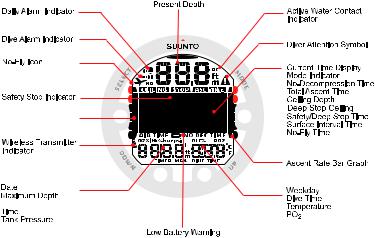
Tank Pressure Bar
Graph
Gas Mix Selection
O2% | He% (Mixed Gas Mode)
(Mixed Gas Mode)
 (Mixed Gas Mode)
(Mixed Gas Mode)
1. WELCOME TO THE WORLD OF SUUNTO DIVE COMPUTERS |
................. 8 |
2. WARNINGS, CAUTIONS, AND NOTES .............................................. |
9 |
3. SUUNTO USER INTERFACE ........................................................ |
18 |
3.1. Navigating in the menus ......................................................... |
18 |
3.2. Button symbols and functions ................................................... |
20 |
4. GETTING STARTED .................................................................. |
22 |
4.1. TIME mode settings .............................................................. |
22 |
4.1.1. Setting the alarm ............................................................ |
23 |
4.1.2. Setting the time .............................................................. |
24 |
4.1.3. Setting the date .............................................................. |
24 |
4.1.4. Setting the units ............................................................. |
25 |
4.1.5. Setting the backlight ........................................................ |
25 |
4.1.6. Setting the tones ............................................................ |
25 |
4.2. AC water contacts ................................................................ |
26 |
4.3. Learning how to use your compass ............................................ |
27 |
4.3.1. Compass display ............................................................ |
28 |
4.3.2. Locking a bearing ........................................................... |
29 |
4.3.3. Compass settings ........................................................... |
30 |
5. BEFORE DIVING ...................................................................... |
34 |
5.1. The Suunto RGBM/Deep Stop Algorithm ...................................... |
34 |
5.2. Emergency ascents .............................................................. |
35 |
5.3. Dive computer limitations ........................................................ |
36 |
5.4. Audible and visual alarms ....................................................... |
36 |
5.5. Error conditions ................................................................... |
39 |
3
5.6. Wireless transmission ............................................................ |
40 |
5.6.1. Installing the wireless transmitter .......................................... |
40 |
5.6.2. Pairing and code selection ................................................. |
41 |
5.6.3. Transmitting data ............................................................ |
43 |
5.7. DIVE mode settings .............................................................. |
44 |
5.7.1. Setting the depth alarm ..................................................... |
45 |
5.7.2. Setting the dive-time alarm ................................................ |
45 |
5.7.3. Setting the nitrox values ................................................... |
46 |
5.7.4. Setting the personal/altitude adjustments ................................ |
47 |
5.7.5. Setting the sample rate ..................................................... |
48 |
5.7.6. Setting the Safety Stops/deep stops ...................................... |
48 |
5.7.7. Setting the RGBM values .................................................. |
49 |
5.7.8. Setting the units ............................................................. |
50 |
5.7.9. Setting the tank pressure alarm ........................................... |
50 |
5.7.10. Setting the tank pressure ................................................. |
51 |
5.7.11. Setting the HP code ....................................................... |
51 |
5.8. Activation and pre-checks ....................................................... |
52 |
5.8.1. Accessing DIVE mode ...................................................... |
52 |
5.8.2. DIVE mode activation ....................................................... |
52 |
5.8.3. Battery power indication .................................................... |
54 |
5.8.4. Diving at altitude ............................................................. |
55 |
5.8.5. Personal adjustments ....................................................... |
56 |
5.9. Safety Stops ....................................................................... |
59 |
5.9.1. Recommended Safety Stops .............................................. |
59 |
4
5.9.2. Mandatory Safety Stops .................................................... |
60 |
5.10. Deep stops ....................................................................... |
61 |
6. DIVING .................................................................................. |
62 |
6.1. Diving in the AIR mode (DIVE Air) ............................................. |
62 |
6.1.1. Basic dive data .............................................................. |
63 |
6.1.2. Bookmark .................................................................... |
64 |
6.1.3. Tank pressure data .......................................................... |
65 |
6.1.4. Ascent rate indicator ........................................................ |
67 |
6.1.5. Safety Stops ................................................................. |
68 |
6.1.6. Decompression dives ....................................................... |
68 |
6.2. Diving in NITROX mode (DIVE Nitrox) ......................................... |
74 |
6.2.1. Before diving in the NITROX mode ....................................... |
74 |
6.2.2. Oxygen displays ............................................................. |
75 |
6.2.3. Oxygen limit fraction (OLF%) .............................................. |
77 |
6.2.4. Gas change and multiple breathing gas mixes .......................... |
77 |
6.3. Diving in the GAUGE mode (DIVE Gauge) ................................... |
78 |
7. AFTER DIVING ......................................................................... |
80 |
7.1. Surface interval ................................................................... |
80 |
7.2. Dive numbering ................................................................... |
81 |
7.3. Repetitive dive planning ......................................................... |
82 |
7.4. Flying after diving ................................................................. |
82 |
7.5. PLAN mode ....................................................................... |
83 |
7.5.1. DIVE PLANNING mode (PLAN NoDec) .................................. |
84 |
7.5.2. Simulation Mode (PLAN Simulator) ....................................... |
86 |
5
7.6. MEMORY mode .................................................................. |
87 |
7.6.1. Dive logbook (MEM Logbook) ............................................. |
88 |
7.6.2. Dive history (MEM History) ................................................. |
90 |
7.7. Suunto DM4 with Movescount .................................................. |
91 |
7.8. Movescount ....................................................................... |
93 |
8. CARE AND MAINTENANCE OF MY SUUNTO DIVING COMPUTER .......... |
94 |
9. BATTERY REPLACEMENT ........................................................... |
97 |
9.1. Battery kit .......................................................................... |
97 |
9.2. Required tools ..................................................................... |
98 |
9.3. Replacing the battery ............................................................. |
98 |
9.4. Wireless transmitter battery replacement .................................... |
102 |
9.4.1. Transmitter battery kit ..................................................... |
102 |
9.4.2. Required tools .............................................................. |
103 |
9.4.3. Replacing the transmitter battery ........................................ |
103 |
10. TECHNICAL DATA .................................................................. |
105 |
10.1. Technical specifications ....................................................... |
105 |
10.2. RGBM ........................................................................... |
109 |
10.2.1. Suunto RGBM adaptive decompression .............................. |
109 |
10.2.2. No-decompression limits for air ......................................... |
110 |
10.2.3. Altitude diving ............................................................. |
113 |
10.3. Oxygen exposure ............................................................. |
113 |
11. INTELLECTUAL PROPERTY ...................................................... |
115 |
11.1. Trademark ...................................................................... |
115 |
11.2. Copyright ........................................................................ |
115 |
6
11.3. Patent notice ................................................................... |
115 |
12. DISCLAIMERS ...................................................................... |
116 |
12.1. CE ............................................................................... |
116 |
12.2. EN 13319 ....................................................................... |
116 |
12.3. EN 250 / FIOH ................................................................. |
116 |
13. SUUNTO LIMITED WARRANTY ................................................. |
117 |
14. DISPOSAL OF THE DEVICE ...................................................... |
119 |
GLOSSARY .............................................................................. |
120 |
7
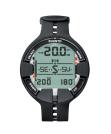
1. WELCOME TO THE WORLD OF SUUNTO DIVE COMPUTERS
Suunto Vyper Air wristop dive computer is designed to help you get the most out of your diving. After reading this manual and becoming familiar with the functions of your dive computer, you'll be ready to take the plunge into a whole new world of diving.
With integrated digital compass and gas switching, Suunto Vyper Air simplifies your diving experience because all the information you need relating to depth, time, tank pressure,decompressionstatus,anddirectionisavailableononeeasy-to-readscreen. TheSuuntoVyperAirUser'sGuidecontainsvitallyimportantinformationwhichenables you to become familiar with your Suunto wristop dive computer. To understand the use, displays, and limitations of the instrument before using it, please read this user's guide carefully, and save it for further reference. Note also that a glossary is included at the back of the user's guide to help you understand dive-specific terminology.
8

2. WARNINGS, CAUTIONS, AND NOTES
Throughout this user's guide, important safety icons are displayed. Three classifications are used to separate these icons by their order of importance:
WARNING |
is used in connection with a procedure or situation that may result |
|
in serious injury or death |
CAUTION |
is used in connection with a procedure or situation that will result |
|
in damage to the device |
NOTE |
is used to emphasize important information |
Before you go on to read the user's guide itself, it is extremely important that you read the following warnings. These warnings are intended to maximize your safety while using Suunto Vyper Air and must not be ignored.
WARNING |
YOU MUST READ the leaflet and user guide for your dive com- |
|
puter. Failure to do so may lead to improper use, serious injury |
|
or death. |
WARNING |
ALLERGIC REACTIONS OR SKIN IRRITATIONS MAY OCCUR |
|
WHEN PRODUCT IS IN CONTACT WITH SKIN, EVEN THOUGH |
|
OUR PRODUCTS COMPLY WITH INDUSTRY STANDARDS. |
|
IN SUCH EVENT, STOP USE IMMEDIATELY AND CONSULT |
|
A DOCTOR. |
9

WARNING |
NOT FOR PROFESSIONAL USE! Suunto dive computers are |
|
intended for recreational use only. The demands of commercial |
|
or professional diving may expose the diver to depths and condi- |
|
tions that tend to increase the risk of decompression illness (DCI). |
|
Therefore, Suunto strongly recommends that the device not be |
|
used for any commercial or professional diving activities. |
WARNING |
ONLY DIVERS TRAINED IN PROPER USE OF SCUBA DIVING |
|
EQUIPMENT SHOULD USE A DIVE COMPUTER! No dive |
|
computer can replace the need for proper dive training. Insufficient |
|
or improper training may cause a diver to commit errors that may |
|
lead to serious injury or death. |
WARNING |
THERE IS ALWAYS A RISK OF DECOMPRESSION ILLNESS |
|
(DCI) FOR ANY DIVE PROFILE EVEN IF YOU FOLLOW THE |
|
DIVE PLAN PRESCRIBED BY DIVE TABLES OR A DIVE |
|
COMPUTER. NO PROCEDURE, DIVE COMPUTER OR DIVE |
|
TABLE WILL PREVENTTHE POSSIBILITYOF DCI OR OXYGEN |
|
TOXICITY! An individual’s physiological make up can vary from |
|
day to day. The dive computer cannot account for these variations. |
|
You are strongly advised to remain well within the exposure limits |
|
provided by the instrument to minimize the risk of DCI. As an |
|
added measure of safety, you should consult a physician regarding |
|
your fitness before diving. |
10

WARNING |
SUUNTO STRONGLY RECOMMENDS THAT SPORT DIVERS |
|
LIMIT THEIR MAXIMUM DEPTH TO 40 M/130 FT OR TO THE |
|
DEPTH CALCULATED BY THE COMPUTER BASED ON THE |
|
SELECTED O2% AND A MAXIMUM PO2 OF 1.4 BAR! Exposure |
|
to greater depths increases the risk of oxygen toxicity and decom- |
|
pression illness. |
WARNING |
DIVES WITH REQUIRED DECOMPRESSION STOPS ARE NOT |
|
RECOMMENDED. YOU SHOULD ASCEND AND BEGIN DE- |
|
COMPRESSION IMMEDIATELY WHEN THE DIVE COMPUTER |
|
SHOWSYOU THAT A DECOMPRESSIONSTOP IS REQUIRED! |
|
Note the blinking ASC TIME symbol and the upward pointing ar- |
|
row. |
WARNING |
USE BACK-UP INSTRUMENTS! Ensure that you use back-up |
|
instrumentation, including a depth gauge, submersible pressure |
|
gauge, timer or watch, and have access to decompression tables |
|
whenever diving with the dive computer. |
WARNING |
PERFORM PRE-CHECKS! Always activate and check the device |
|
before diving in order to ensure that all Liquid Crystal Display |
|
(LCD) segments are completely displayed, the device has not |
|
run out of battery power, and that the oxygen, altitude, personal, |
|
RGBM adjustments, and Safety/Deep Stop are correct. |
11

WARNING |
YOU ARE ADVISED TO AVOID FLYING ANY TIME THE COM- |
|
PUTER COUNTS DOWN THE NO-FLY TIME. ALWAYS ACTIV- |
|
ATE THE COMPUTER TO CHECK THE REMAINING NO-FLY |
|
TIME PRIOR TO FLYING! Flying or traveling to a higher altitude |
|
within the no-fly time can greatly increase the risk of DCI. Review |
|
the recommendations given by Divers Alert Network (DAN). There |
|
can never be a flying after diving rule that is guaranteed to com- |
|
pletely prevent decompression illness! |
WARNING |
THE DIVE COMPUTER SHOULD NEVER BE TRADED OR |
|
SHARED BETWEEN USERS WHILE IT IS IN OPERATION! Its |
|
information will not apply to someone who has not been wearing |
|
it throughout a dive or sequence of repetitive dives. Its dive profiles |
|
must match that of the user. If it is left on the surface during any |
|
dive, the dive computer will give inaccurate information for sub- |
|
sequent dives. No dive computer can take into account dives |
|
made without the computer. Thus, any diving activity up to four |
|
days prior to initial use of the computer may cause misleading |
|
information and must be avoided. |
WARNING |
DO NOT EXPOSE ANY PART OF YOUR DIVE COMPUTER TO |
|
ANY GAS MIX CONTAINING MORE THAN 40% OXYGEN! En- |
|
riched air with greater oxygen content presents a risk of fire or |
|
explosion and serious injury or death. |
12

WARNING |
THE DIVE COMPUTER WILL NOT ACCEPT FRACTIONAL |
|
PERCENTAGE VALUES OF OXYGEN CONCENTRATION. DO |
|
NOT ROUND UP FRACTIONAL PERCENTAGES! For example, |
|
31.8% oxygen should be entered as 31%. Rounding up will cause |
|
nitrogen percentages to be understated and will affect decompres- |
|
sion calculations. If there is a desire to adjust the computer to |
|
provide more conservative calculations, use the personal adjust- |
|
ment feature to affect decompression calculations or reduce the |
|
PO2 setting to affect oxygen exposure according to the entered |
|
O2% and PO2 values. |
WARNING |
SET THE CORRECT ALTITUDE ADJUSTMENT MODE! When |
|
diving at altitudes greater than 300 m/1000 ft, the Altitude Adjust- |
|
ment feature must be correctly selected in order for the computer |
|
to calculate the decompression status. The dive computer is not |
|
intended for use at altitudes greater than 3000 m/10000 ft. Failure |
|
to select the correct Altitude Adjustment setting or diving above |
|
the maximum altitude limit will result in erroneous dive and plan- |
|
ning data. |
13

WARNING |
SET THE CORRECT PERSONAL ADJUSTMENT MODE! |
|
Whenever it is believed that factors that tend to increase the |
|
possibility of DCI exist, it is recommended that you use this option |
|
to make the calculations more conservative. Failure to select the |
|
correct Personal Adjustment setting will result in erroneous dive |
|
and planning data. |
WARNING |
DO NOT EXCEED THE MAXIMUM ASCENT RATE! Rapid as- |
|
cents increase the risk of injury. You should always make the |
|
Mandatory and Recommended Safety Stops after you have ex- |
|
ceeded the maximum recommended ascent rate. If this Mandatory |
|
Safety Stop is not completed the decompression model will pen- |
|
alize your next dive(s). |
WARNING |
YOUR ACTUAL ASCENT TIME MAY BE LONGER THAN DIS- |
|
PLAYED BY THE INSTRUMENT! The ascent time will increase |
|
if you: |
|
• remain at depth |
|
• ascend slower than 10 m/min / 33 ft/min or |
|
• make your decompression stop deeper than at the ceiling |
|
These factors will also increase the amount of air required to |
|
reach the surface. |
14

WARNING |
NEVER ASCEND ABOVE THE CEILING! You must not ascend |
|
above the ceiling during your decompression. In order to avoid |
|
doing so by accident, you should stay somewhat below the ceiling. |
WARNING |
DO NOT DIVE WITH A CYLINDER OF ENRICHED AIR IF YOU |
|
HAVE NOT PERSONALLY VERIFIED ITS CONTENTS AND |
|
ENTERED THE ANALYSIS VALUE INTO YOUR DIVE COM- |
|
PUTER! Failure to verify cylinder contents and enter the appropri- |
|
ate O2% into your dive computer will result in incorrect dive |
|
planning information. |
WARNING |
DO NOT DIVE WITH A GAS IF YOU HAVE NOT PERSONALLY |
|
VERIFIED ITS CONTENTS AND ENTERED THE ANALYZED |
|
VALUE INTO YOUR DIVE COMPUTER! Failure to verify cylinder |
|
contents and enter the appropriate gas values where applicable |
|
into your dive computer will result in incorrect dive planning inform- |
|
ation. |
WARNING |
Diving with gas mixtures exposes you to risks that are different |
|
from those associated with diving with standard air. These risks |
|
are not obvious, and require training to understand and avoid. |
|
Risks include possible serious injury or death. |
15

WARNING |
Traveling to a higher elevation can temporarily cause a change |
|
in the equilibrium of dissolved nitrogen in the body. It is recom- |
|
mended that you acclimatize to the new altitude by waiting at |
|
least three hours before diving. |
WARNING |
WHEN THE OXYGEN LIMIT FRACTION INDICATES THAT THE |
|
MAXIMUM LIMIT IS REACHED, YOU MUST IMMEDIATELY |
|
TAKE ACTION TO REDUCE OXYGEN EXPOSURE. Failure to |
|
take action to reduce oxygen exposure after the warning is given |
|
can rapidly increase the risk of oxygen toxicity, injury, or death |
WARNING |
Suunto also recommends that you receive training in Free diving |
|
techniques and physiology before conducting breath hold dives. |
|
No dive computer can replace the need for proper dive training. |
|
Insufficient or improper training may cause a diver to commit errors |
|
that may lead to serious injury or death. |
WARNING |
If there are several divers using the dive computer with wireless |
|
transmission, always ensure that each diver is using a different |
|
code before starting the dive. |
16

WARNING |
Using the Suunto Dive Planner software is not a substitute for |
|
proper dive training. Diving with mixed gases has dangers that |
|
are not familiar to divers diving with air. To dive with trimix, triox, |
|
heliox and nitrox or all of them, divers must have specialized |
|
training for the type of diving they are doing. |
WARNING |
Always use realistic SAC rates and conservative turn pressures |
|
during dive planning. Overly optimistic or erroneous gas planning |
|
can result in the exhaustion of breathing gas during decompres- |
|
sion or in a cave or a wreck. |
WARNING |
ENSURE THE WATER RESISTANCE OF THE DEVICE! Moisture |
|
inside the device or battery compartment will seriously damage |
|
the unit. Only an authorized SUUNTO dealer or distributor should |
|
do service activities. |
NOTE |
It is not possible to change between AIR, NITROX and GAUGE |
|
modes before the instrument has counted down the no-fly time. |
|
There are, however, exceptions to this: You can change from AIR |
|
to NITROX mode, as well as from AIR or NITROX mode to |
|
GAUGE mode even during the no-fly time. |
|
When planning both air and nitrox dives during the same dive |
|
series, you should set the instrument in NITROX mode and |
|
modify the gas mix accordingly. |
In GAUGE mode the no-fly time is always 48 hours.
17
3. SUUNTO USER INTERFACE
3.1. Navigating in the menus
Suunto Vyper Air has four main operating modes - TIME mode (TIME), DIVE mode (DIVE), PLAN mode (PLAN), and MEMORY mode (MEMORY) – as well as the COMPASS submode, which can be activated from either TIME or DIVE modes. To toggle between the main modes, press the MODE button. To select a submode in DIVE, PLAN and MEMORY modes, press the UP/DOWN buttons.
18
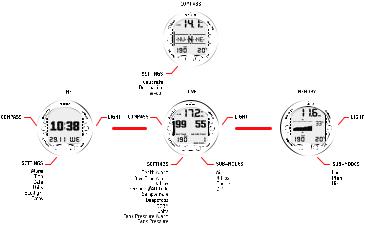
19
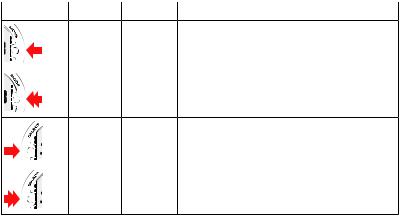
3.2. Button symbols and functions
The table below explains the main functions of the dive computer's buttons. The buttons and their use is explained in more detail in the relevant sections of the user's guide.
Table 3.1. Button symbols and functions
Symbol |
Button |
Press |
Main functions |
|
MODE |
Short |
Switch between main modes |
|
|
|
Switch from submode to main mode |
|
|
|
Activate backlight in DIVE mode |
|
MODE |
Long |
Activate backlight in other modes |
|
|
|
Activate stopwatch in DIVE mode |
|
SELECT |
Short |
Select a submode |
|
|
|
Select and accept settings |
|
|
|
Select stopwatch to stop or start in DIVE mode |
|
SELECT |
Long |
Activate compass in TIME and DIVE modes |
20
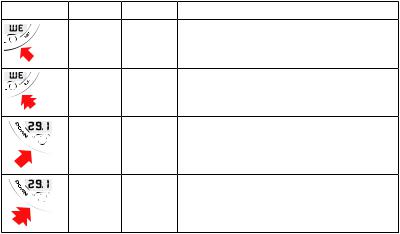
Symbol |
Button |
Press |
Main functions |
|
UP |
Short |
Toggle between alternative displays |
|
|
|
Change submode |
|
|
|
Increase values |
|
UP |
Long |
Activate gas switching in NITROX mode |
|
DOWN |
Short |
Toggle between alternative displays |
|
|
|
Change submode |
|
|
|
Decrease values |
|
DOWN |
Long |
Enter Setting mode |
21

4. GETTING STARTED
To get the most out of your Suunto Vyper Air, use some time to personalize it and really make it YOUR computer. Set the correct time and date, as well as the alarms and tones, unit and backlight settings. Then, calibrate and test the compass function. If you are going to use the optional wireless pressure transmitter, install it and enable the pressure transmission in the Suunto Vyper Air’s settings then test the pressure transmission.
Suunto Vyper Air is a very user-friendly dive computer, and you will quickly become familiar with its functions. Make absolutely sure that you know your computer and have it set up as you want it BEFORE getting into the water.
4.1. TIME mode settings
The first thing to do with your Suunto Vyper Air, is to modify the TIME mode settings: the time, alarm, date, units, backlight, and tones.
NOTE |
The display is illuminated by holding down the MODE button for |
|
more than 2 seconds. |
22
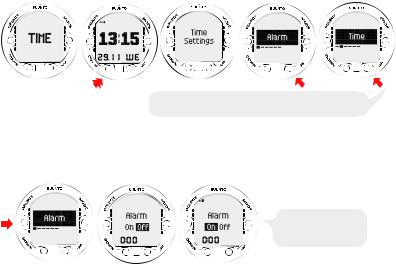
The figure below shows how to enter the TIME Settings menu.
USE UP AND DOWN BUTTONS TO TOGGLE BETWEEN ALARM, TIME,
DATE, UNITS, BACKLIGHT AND TONES.
4.1.1. Setting the alarm
The dive computer has a daily alarm function. When the daily alarm activates, the screen blinks and the alarm sounds for 60 seconds. Press any button to stop the alarm.
ADJUST WITH UP AND
DOWN BUTTONS. ACCEPT
WITH SELECT BUTTON.
23
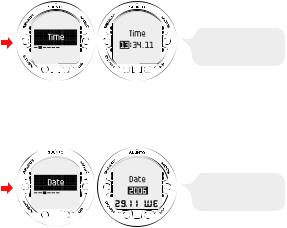
4.1.2. Setting the time
In the Time setting mode, you are able to set the hour, minute, and second, as well as choose between a 12 and 24 hour display.
ADJUST WITH UP AND
DOWN BUTTONS. ACCEPT
WITH SELECT BUTTON.
4.1.3. Setting the date
In the Date setting mode, you are able to set the year, month, and day. The day of the week is automatically calculated in accordance with the date. In metric units the date is presented as DD/MM, and in imperial units as MM/DD.
ADJUST WITH UP AND
DOWN BUTTONS. ACCEPT
WITH SELECT BUTTON.
24
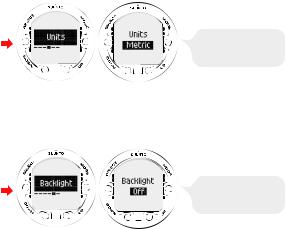
4.1.4. Setting the units
In the Units setting mode, you are able to choose whether the units are displayed in either the metric or imperial system (meters/feet, Celsius/Fahrenheit, and so on).
ADJUST WITH UP AND
DOWN BUTTONS. ACCEPT
WITH SELECT BUTTON.
4.1.5. Setting the backlight
In the Backlight setting mode, you are able to turn the backlight ON or OFF and to define how long it stays on for (5, 10, 20, 30, or 60 seconds). When the backlight is turned OFF, it does not illuminate when an alarm sounds.
ADJUST WITH UP AND
DOWN BUTTONS. ACCEPT
WITH SELECT BUTTON.
4.1.6. Setting the tones
In the Tones setting mode, you are able to activate or deactivate the tones.
25
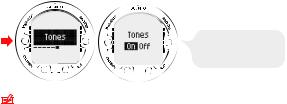
ADJUST WITH UP AND
DOWN BUTTONS. ACCEPT
WITH SELECT BUTTON.
NOTE |
When the tones are off, there are no audible alarms. |
4.2. AC water contacts
The water and data transfer contact is located on the rear of the case. When submerged, the water contact poles are connected by the conductivity of the water and the “AC” symbol appears on the display. The AC text is shown until the water contact deactivates.
26

AC APPEARS IN THE TOP RIGHT
CORNER OF THE DISPLAY, WHEN THE DIVE
COMPUTER IS IN CONTACT WITH WATER.
THIS ALSO ACTIVATES THE DIVE MODE.
Contamination or dirt on the water contact may prevent this automatic activation. Therefore, it is important that the water contact is kept clean. The contact can be cleaned with fresh water and a soft brush, for example a tooth brush.
4.3. Learning how to use your compass
Suunto Vyper Air integrates a digital compass, which can be used both while diving and on dry land, and can be accessed from either the DIVE mode or TIME mode.
27
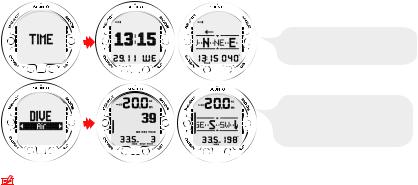
IF ACCESSED FROM TIME MODE,
TIME AND BEARING ARE DISPLAYED AT
THE BOTTOM OF THE SCREEN.
IF ACCESSED FROM DIVE MODE,
CURRENT DEPTH AND TIME OR
MAXIMUM DEPTH, AS WELL AS BEARING
OR DIVE TIME OR TEMPERATURE ARE
DISPLAYED.
NOTE |
When accessed from DIVE mode, toggle between the alternative |
|
displays by pressing the UP/DOWN buttons. |
4.3.1. Compass display
The Suunto Vyper Air displays the compass as a graphical representation of a compass rose. The rose displays the cardinal and half cardinal points, in addition to which, the current bearing is also displayed numerically.
28
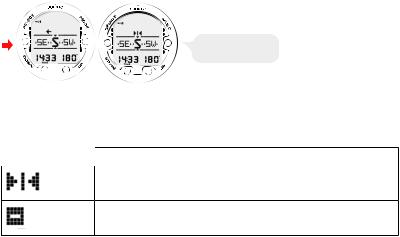
4.3.2. Locking a bearing
A bearing can be locked to help you follow a selected course, and directional arrows point towards the locked bearing. The last locked bearing is stored and is available the next time the compass is activated. In the DIVE mode the locked bearings are also stored in the log.
TO LOCK A BEARING,
PRESS SELECT.
The Suunto Vyper Air also provides help for navigating square and triangular patterns, as well as navigating a return heading. This is made possible by following graphical symbols in the center of the compass display:
Table 4.1. Locked bearing symbols
 Symbol
Symbol  Explanation
Explanation
You are traveling towards the locked bearing
You are 90 (or 270) degrees from the locked bearing
29
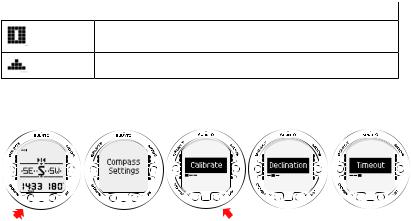
 Symbol
Symbol  Explanation
Explanation
You are 180 degrees from the locked bearing
You are 120 (or 240) degrees from the locked bearing
4.3.3. Compass settings
You can define the compass settings (Calibration, Declination and Timeout) in the COMPASS mode:
Calibration
Because of changes in the surrounding magnetic field, the Suunto Vyper Air electronic compass occasionally needs to be re-calibrated. During the calibration process, the compass adjusts itself to the surrounding magnetic field and to tilting. As a basic rule, you should calibrate the compass whenever it does not seem to operate properly, or after replacing the dive computer's battery.
30
